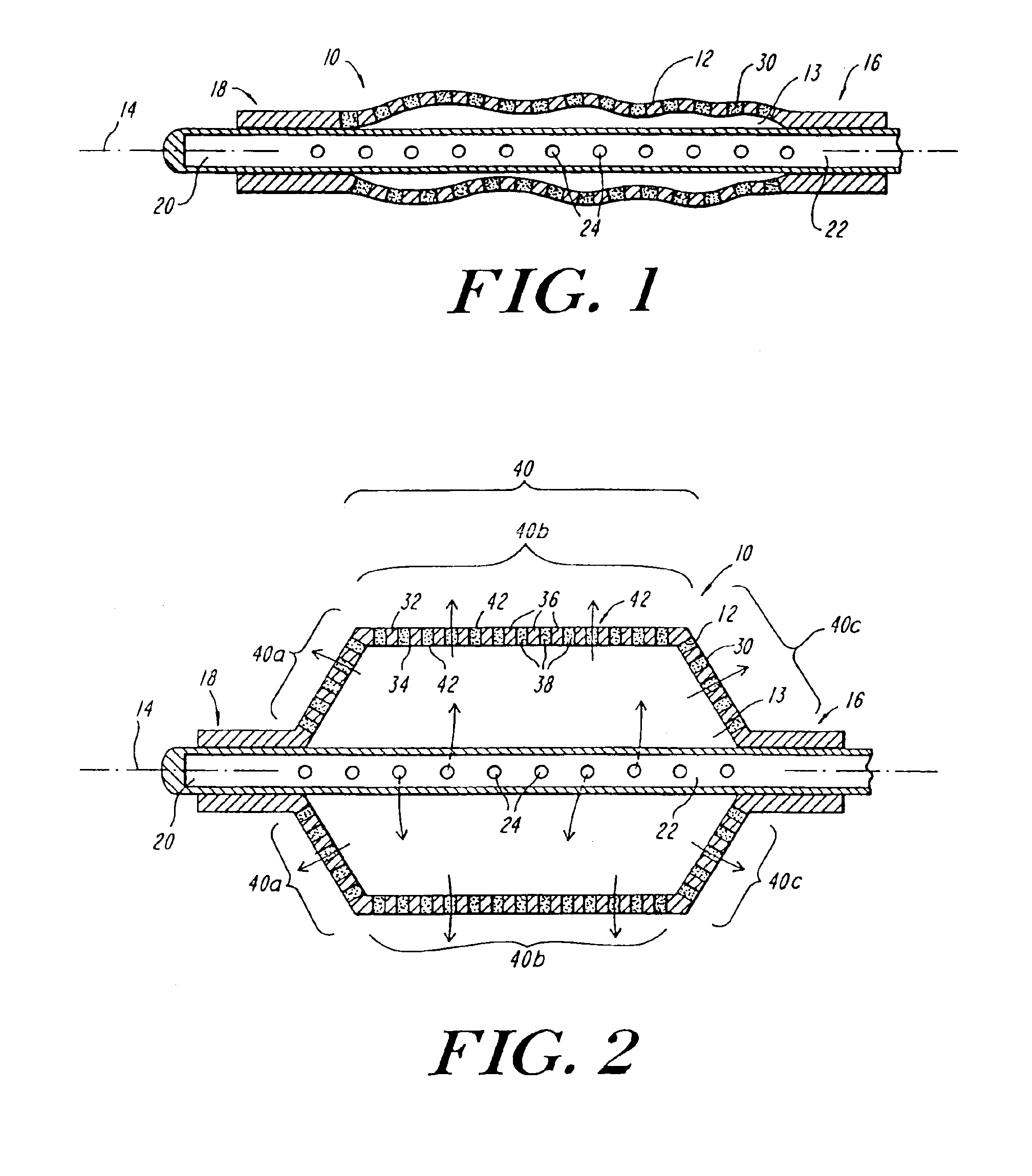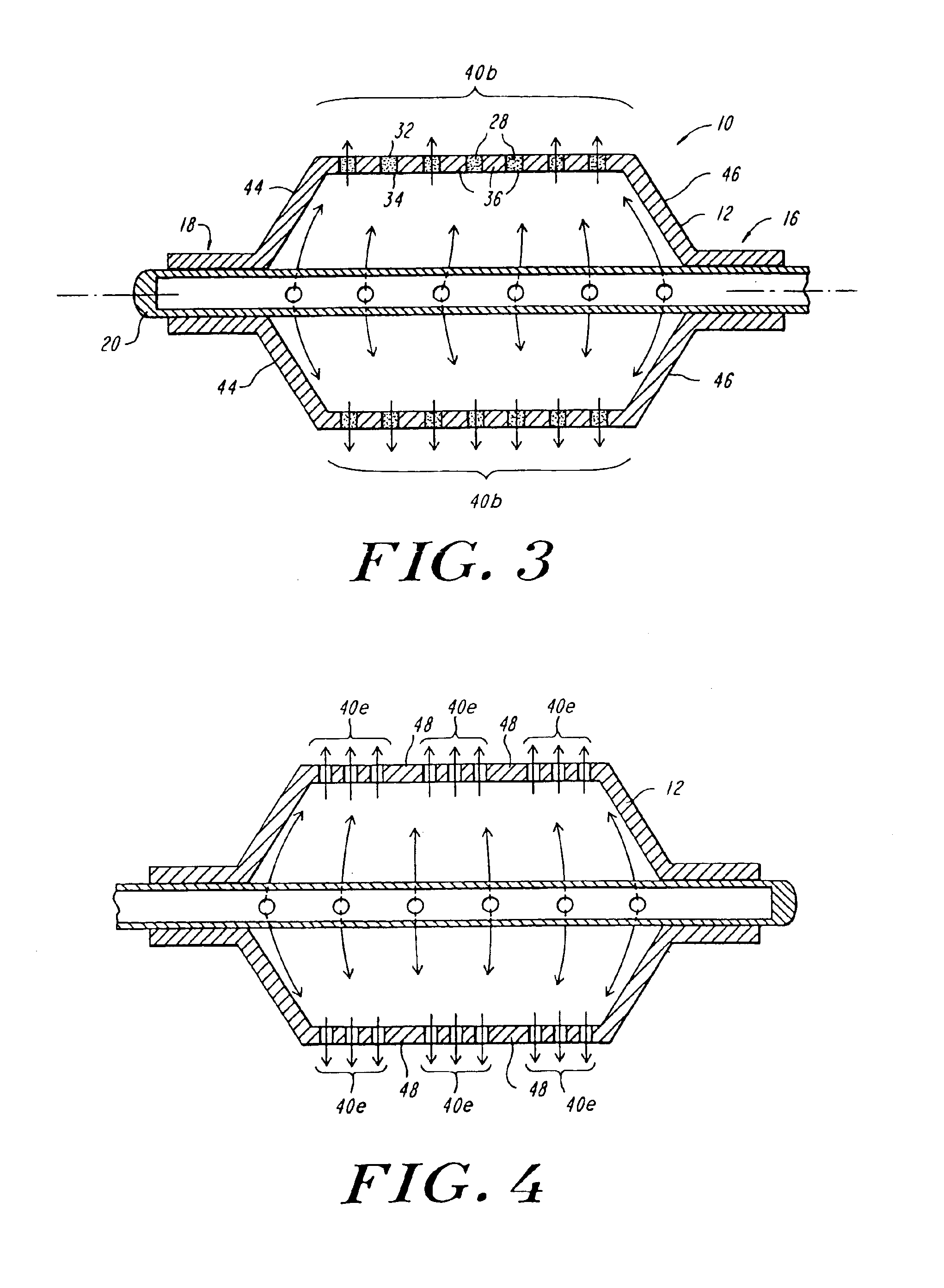Expandable fluoropolymer device for delivery of therapeutic agents and method of making
a fluoropolymer and balloon technology, applied in the direction of dilators, catheters, other domestic objects, etc., can solve the problems of difficult control of the flow rate and uniform delivery of fluid through the balloon walls, the inability of the therapeutic agent to properly penetrate the tissue at the treatment site, and the inability to effectively deliver the fluid. , to achieve the effect of effective delivery of fluid
- Summary
- Abstract
- Description
- Claims
- Application Information
AI Technical Summary
Benefits of technology
Problems solved by technology
Method used
Image
Examples
example 1
[0085]An exemplary fluid delivery device was constructed according to the manufacturing processes of the present invention by employing 0.068″ (ID) / 0.088″ (OD) ePTFE tubing. The longitudinal stretch ratio of the ePTFE tube was 1.5: 1, at a stretch rate of 10 inches per second. An electron micrograph of an exterior section of a sample ePTFE tube, after stretching, is shown in FIG. 14A. FIG. 14A illustrates the microstructure of nodes interconnected by fibils of the ePTFE tubing and, in particular, the orientation of the nodes generally perpendicular to the longitudinal axis of the tubing and the intemodal through-pores. An 8 mm×8 cm PET balloon was employed to radially expand the ePTFE tubing. The PET balloon was attached to a vacuum source and a slight vacuum was placed on the PET balloon, about −5 to −10 psi. The ePTFE tubing was then positioned over the deflated PET balloon. The PET balloon and the ePTFE tubing were then connected to a hypo-tube and placed into a water heated cham...
example 2
[0088]Three ePTFE synthetic grafts were treated using an ePTFE diffusion balloon constructed in accordance with the method of Example 1 to determine the permeability of a contrast agent into the grafts. The diffusion balloon employed was 8 cm in length, had an OD of 6 mm and was constructed from an 0.088″ (OD) / 0.068″ (ID) ePTFE tube having a stretch ratio of 1.5:1. Each of the grafts treated was an Atrium Hybrid PTFE graf model no. 01200670, available from Atrium Medical of Hudson, N.H. The grafts had a 6mm inner diameter and a wall thickness of 0.025 inches. In each case, the balloon was inserted into a graft and inflated by infusing a contrast agent. The balloon was inflated to 1 atm. by the infused fluid. The balloon was then removed from the graft and the graft was flushed with water delivered at 500 ml / min. The contrast agent used was Hypaque-76 available from Mycomed, Inc. Table 1 summarizes each procedure.
[0089]
TABLE 1Duration of BalloonBalloon InfusionGraft FlushingGraft Sam...
example 3
[0093]The permeability of several ePTFE fluid delivery devices constructed in accordance with the manufacturing processes of the present invention was evaluated and compared with the permeability of selected synthetic grafts. Each of the fluid delivery devices was constructed from an extruded and expanded ePTFE tube as set forth in
[0094]Table 3.
[0095]
TABLE 3FluidStretchWallDeliveryRatioStretch Rate ofThickness ofSurface Area ofDeviceof ePTFEePTFE tubeFluid DeliveryFluid DeliverySampletube(in / s)Device (in)Device (in2)11.5:1200.00680.45621.75:1 100.00550.4693 3:1100.0050.4694 5.1100.0030.50351.25:1 100.00750.39961.5:10.50.00550.39971.5:1100.0050.39981.5:1100.0050.29
[0096]The synthetic grafts analyzed were standard and thin wall grafts available from Atrium Medical Corporation and W. L. Gore & Associates, Inc. Information regarding the grafts in Table 4
[0097]
TABLE 4Graft sampleTypeWall Thickness (in)Surface Area (in2)AAtrium 6 mm std0.0250.964BAtrium 6 mm thin0.0220.963CGore 7 mm thi...
PUM
| Property | Measurement | Unit |
|---|---|---|
| pressure | aaaaa | aaaaa |
| flow rate | aaaaa | aaaaa |
| width | aaaaa | aaaaa |
Abstract
Description
Claims
Application Information
 Login to View More
Login to View More - R&D
- Intellectual Property
- Life Sciences
- Materials
- Tech Scout
- Unparalleled Data Quality
- Higher Quality Content
- 60% Fewer Hallucinations
Browse by: Latest US Patents, China's latest patents, Technical Efficacy Thesaurus, Application Domain, Technology Topic, Popular Technical Reports.
© 2025 PatSnap. All rights reserved.Legal|Privacy policy|Modern Slavery Act Transparency Statement|Sitemap|About US| Contact US: help@patsnap.com



